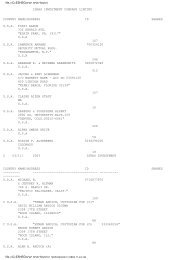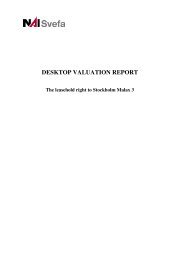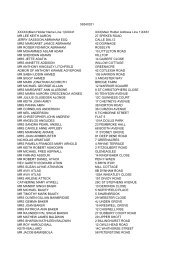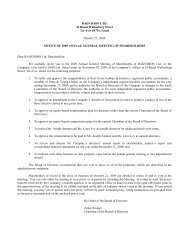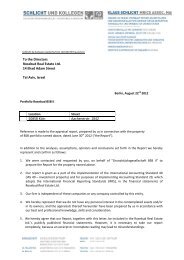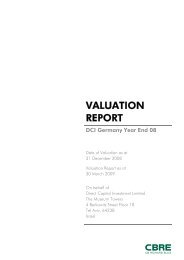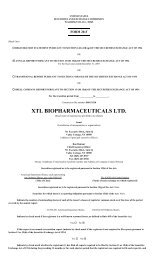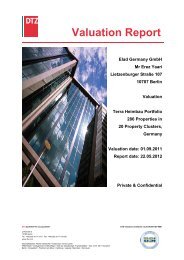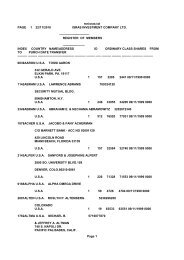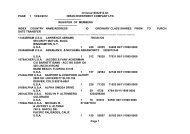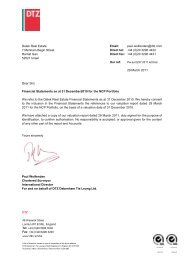RETALIX LTD.
RETALIX LTD.
RETALIX LTD.
Create successful ePaper yourself
Turn your PDF publications into a flip-book with our unique Google optimized e-Paper software.
Tax provision<br />
We operate in a number of countries and, as such, fall under the jurisdiction of a number of tax authorities. We are subject to income taxes in these<br />
jurisdictions and we use estimates in determining our provision for income taxes. Deferred tax assets, related valuation allowances and deferred tax<br />
liabilities are determined separately by tax jurisdiction. This process involves estimating actual current tax liabilities together with assessing temporary<br />
differences resulting from differing treatment of items for tax and accounting purposes. These differences result in deferred tax assets and liabilities, which<br />
are recorded on our balance sheet. We assess the likelihood that deferred tax assets will be recovered from future taxable income, and a valuation<br />
allowance is provided for if it is more likely than not that some portion of the deferred tax assets will not be recognized. Although we believe that our tax<br />
estimates are reasonable, the ultimate tax determination involves significant judgment that could become subject to audit by tax authorities in the ordinary<br />
course of business. In our opinion, sufficient tax provisions have been included in our consolidated financial statements in respect of the years that have not<br />
yet been assessed by tax authorities. On a quarterly basis, we also reassess the amounts recorded for deferred taxes and examine whether any amounts need<br />
to be added or released.<br />
Other non critical accounting policies and additional discussion of accounting characteristics<br />
Our Functional Currency<br />
Our consolidated financial statements are prepared in U.S. dollars in accordance with U.S. generally accepted accounting principles. The currency of<br />
the primary environment in which we operate is the U.S. dollar. We generally generate revenues in dollars or in NIS linked to the dollar. Our financing is<br />
also comprised primarily of dollar denominated loans. As a result, the dollar is our functional currency. Transactions and balances originally denominated<br />
in dollars are presented at their original amounts. Balances in non-dollar currencies are translated into dollars using historical and current exchange rates<br />
for non-monetary and monetary balances, respectively. For non-dollar transactions and other items (stated below) reflected in the statements of income<br />
(loss), the following exchange rates are used: (1) for transactions – exchange rates at transaction dates or average rates of the period reported and (2) for<br />
other items (derived from non-monetary balance sheet items such as depreciation and amortization, changes in inventories, etc.) – historical exchange rates.<br />
Currency transaction gains or losses are carried to financial income or expenses, as appropriate.<br />
The functional currency of Retalix Italia and Cell-Time is their local currency (Euro and New Israeli Shekel, respectively). The financial statements<br />
of Retalix Italia are included in our consolidated financial statements translated into dollars in accordance with SFAS 52 “Foreign Currency Translation” of<br />
the FASB, or SFAS 52. Accordingly, assets and liabilities are translated at year end exchange rates, while operating results items are translated at average<br />
exchange rates during the year. Differences resulting from translation are presented in shareholders’ equity under “accumulated other comprehensive<br />
income (loss).” The financial statements of Cell-Time are included in our financial statements under the equity method, based on translation into dollars in<br />
accordance with SFAS 52; the resulting translation adjustments are presented under shareholders’ equity, in the line item “Accumulated other<br />
comprehensive income.”<br />
Bad debt and allowance for doubtful accounts<br />
We maintain an allowance for doubtful accounts to reflect estimated losses resulting from the inability of certain of our customers to make required<br />
payments. We regularly evaluate the adequacy of our allowance for doubtful accounts by taking into account variables such as past experience, age of the<br />
receivable balance and current economic conditions of the party owing the receivable balance. If the financial conditions of certain of our customers were<br />
to deteriorate, resulting in an impairment in their ability to make payments, additional allowance for doubtful accounts may be required.<br />
Variable Interest Entities<br />
We evaluate whether entities in which we have invested are variable interest entities within the meaning of FIN 46R. If an entity is a variable interest<br />
entity, then we determine whether we are the primary beneficiary of that entity by reference to our contractual and business arrangements. Assessment of<br />
whether an entity is a variable interest entity for purposes of FIN 46R and the determination of the primary beneficiary of such entity requires judgment<br />
and careful analysis of all relevant facts and circumstances, including determining whether other parties are related parties solely for the purposes of FIN<br />
46R.<br />
StoreNext USA is a variable interest entity, which the Company holds majority of voting interest and, under the relevant guidelines of Financial<br />
Accounting Standards Board Interpretation No. 46R, "Accounting for Variable Interest Entities" ("FIN 46R"), we are considered the primary beneficiary,<br />
and therefore we consolidate the results of StoreNext into our financial statements.<br />
Sources of Revenue<br />
We derive our revenues primarily from the licensing of integrated software products, and to some extent also from the sale of complementary<br />
computer and other hardware equipment, all which we classify as revenues from product sales. We also derive revenues from maintenance and other<br />
services which are principally software changes and enhancements requested by customers, all associated with our software products, which we classify as<br />
revenues from services and projects. In addition, we provide business flow communication services between retailers and suppliers, data analysis and<br />
supply chain information services to suppliers as well as manufacturers and on-line application services primarily to small independent retailers. We do<br />
business through subsidiaries in the United States, Israel, the United Kingdom, Italy, France and Australia.<br />
Our relationships primarily with our large customers, are long-term in nature, as they involve the supply of products that require considerable<br />
customer commitment, attention and investment of financial and human resources.<br />
During 2005, one single customer accounted for 5% or more of our revenues and during 2004, none of our customers accounted for 5% or more of<br />
our revenues.



